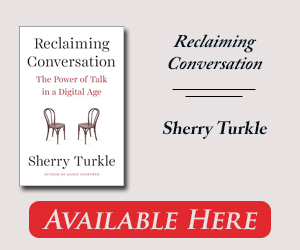
Reclaiming Conversation: The Power of Talk in a Digital Age by Sherry Turkle; Penguin Press, 448 pp., $27.95
In 2012, two University of Essex researchers reported the results of a thoroughly alarming study: The presence of a cell phone on a nearby desk led college students, who’d been paired off to converse for 10 minutes, to feel more distanced from, less empathetic toward, and less trusting of their discussion partners. Students also rated the brief relationships they’d formed as being of a lower quality.
It was the intimacy of conversations that really took a hit, the researchers found. When discussions were casual, the cell phone on the desk made little difference. But when conversations touched on more meaningful topics, the device—though it remained still, silent, off to the side, and unanswered—discouraged conversation partners from warming to one another.
In the real world, of course, our phones often aren’t silent and off to the side. They are buzzing and beeping and playing “Master of Puppets.” Or they are doing none of these things, but we check them anyway because perhaps they did buzz and we missed it. According to MIT media scholar Sherry Turkle, our face-to-face conversations are suffering as a result.
In this book, a follow-up to her 2011 book, Alone Together: Why We Expect More from Technology and Less from Each Other, Turkle again confronts the psychological toll of digital devices. Drawing from hundreds of interviews, she makes a convincing case that our unfettered ability to make digital connections is leading to a decline in actual conversation—between friends and between lovers, in classrooms and in places of work, even in the public sphere. In having fewer meaningful conversations each day, Turkle argues, we’re losing the skills that made them possible to begin with—the ability to focus deeply, think things through, read emotions, and empathize with others.
Ready to fill the gap—quite literally any gap—are emails and texts, online discussion boards and Facebook posts. These media offer irresistible terms, allowing us to control when, how, and the extent to which we connect. Technology that was originally intended to bring us together has instead changed how we want to be together.
Many of Turkle’s portraits are somewhat familiar: the partygoers glued to their phones, searching for other, better parties; the family that prefers to argue via text messages; the manager exasperated with her face-time-shunning colleagues, despite numerous studies showing that “face-to-face conversation leads to higher productivity and is also associated with reduced stress.” Even the more brow-raising data she provides—like a study finding that caregivers who dine at fast food restaurants spend more time on their phones than they do interacting with their young charges—aren’t surprising enough to stun.
But this familiarity only strengthens her argument. Turkle doesn’t introduce us to a world where other people live; she colors the corners of the world we inhabit. An avowed descriptivist—someone far more interested in describing communication than condemning it—I, too, am uncomfortable with how easily I reach for my iPhone during a moment of downtime, and how speedily my notion of downtime has expanded. What conversations am I not having? As my 21-year-old niece put it, an electronic device is filler, but “it’s hard to tell whether it is filling blank space or filling something else.”
Turkle writes with a scholar’s caution, hedging where appropriate. Still, for all her thoughtfulness, she appears curiously indifferent to the limits of her thesis. Surely some people allow digital connections to coexist with, or even augment, conversation. Who are they? This is not a book about the online communities that spring up around rare genetic disorders, or even the grandmother in California who coaxes a real-time smile out of her youngest grandchild in Phoenix. And that’s okay. But it is tough to gauge the decline in conversation without knowing who is still talking, or to make sense of what has been lost without a fair appraisal of what has been gained.
Turkle’s solution, however, is considered and astute. Being addicted to technology isn’t like being addicted to heroin. We don’t all need to return to flip phones or disable our company’s hotspots. Instead, she suggests, we should acknowledge that we are “extremely vulnerable” to some of the technologies that surround us and that “the path forward is to learn more about our vulnerabilities.” Only then can we design new technologies and processes for using them in response.
Clearly, a market exists for technology that bolsters our defenses. Today we can download apps that limit the uses of our devices, log the time we spend on them, and motivate us to spend less. There is also, as The New York Times recently reported, the smartphone-shaped NoPhone—a plastic “security blanket for people who want to curb their phone addiction but are afraid to leave home without something to hold on to.” Overkill? Perhaps. But Turkle would approve.


